Facebook Social Listening: Strategy, Tips & Best Tools for 2025
Tabela de conteúdo
Why is Facebook social listening essential in 2025? Apple launched a new iPhone and Facebook exploded. 10K mentions in 30 days. 243M people reached. But here’s what matters more than those numbers – somewhere in those mentions, a customer posted concerns about an orange iPhone turning pink. By morning, it was a 50-comment thread. Real questions, real customer, real PR problem.
If you’re just counting mentions, you miss it. If you’re Facebook listening (reading sentiment, tracking patterns), you know exactly what to do next.
That’s what Facebook social listening is about. In this guide, I’ll show you how to use it effectively!
- What is Facebook social listening?
Facebook listening is the practice of tracking public posts, brand mentions, competitor mentions, and social conversations across social media channels on Facebook. - Por que isso é importante para as marcas?
It shows how customers perceive your brand in real time (also beyond your profiles and posts you’re tagged in). You spot service issues early, discover trending topics, and refine your brand’s message for the target audience. - How to quickly start social listening on Facebook?
Choose a Facebook social listening tool and add core keywords: your brand, products, competitors, and key hashtags. Create a social listening strategy and follow it – review the mentions daily and act on the top opportunities.
What is Facebook social listening?
Em palavras simples: Social listening on Facebook is collecting Facebook data (public mentions, comments under posts, Pages) via the facebook api and turning it into insights.
You evaluate social sentiment, find trending topics, and spot gaps in your listening strategy.
You then create content, plan campaigns, and refine your company’s growth model.
It goes beyond social monitoring, as you don’t just see messages.
You analyze data, gain insights, and act.
This is what a Facebook mention can look like in the social listening tools dashboard:

How does Facebook social listening work in real life?
Let’s talk about a real example now!
I analyzed Apple’s performance after its recent iPhone 17 release.
Plus, I compared their performance with the main rival – Samsung.
It’s a perfect case study to show you escuta social capabilities and what it can look like.
Here’s the data (source: Brand2 tool, last 30 days).
- Apple:
- Mentions: 10k
- Alcance: 243M
- Positive: 34% (3,384)
- Negative: 2% (198)
- Average Presence Score: 72/100
- AVE: $18M
- Samsung:
- Mentions: 20k
- Alcance: 413M
- Positive: 27% (5,313)
- Negative: 2% (325)
- Average Presence Score: 67/100
- AVE: $24M
What does it mean? (my take)
Samsung won in volume and reach (20k mentions; 413M reach), but Apple led in quality (higher positive share and higher presence score).
- If I were Apple, I would double down on feature education and creators who can turn that goodwill into how-to content and comparison posts.
- If I were Samsung, I’d mine the threads for service issues and friction topics. Volume is on our side; we convert volume to advocacy by fixing the few negatives fast.

Why are Facebook mentions important?
Porque customers perceive your brand through social media platforms long before they visit your website.
Facebook mentions show how people talk about your brand on Facebook’s various pages.
They reveal what customers love, what frustrates them, and which messages travel beyond the platform, across other social media channels, or even further.
As Phil Pallen, Brand Strategist, says:
Plus, there’s more to it.
In the AI era, online talk shapes how your brand is presented in the LLMs (and if it appears there in the beginning)
You need to remember that also unlinked mentions shape brand perception – both people and algorithms still see them and value them greatly.
Observação importante: You’ll capture public posts and public comments; you won’t capture private messages or closed groups.
That’s true for all social listening tools due to platform rules.
Why monitor Facebook mentions?
- Mentions are feedback. They expose the customers’ mindset, objections, and language you should mirror in your content.
- A sudden rise in negative mentions shows issues before they escalate.
- Tracking brand mentions and competitor mentions shows where you stand in your category and which topics you “own.”
- This analysis is a fuel for campaigns. You can pull phrases from positive mentions and industry trends to craft copy, promotional ads, and creator briefs. Turn complaints into clear how-tos and fixes.
- Social media mentions are what feed LLMs and search engines. If you ignore mentions, you miss AI visibility.
- Mentions reveal market trends, feature requests, and usability gaps that roadmaps can address. Almost 41% of consumers use social media to discover new products and services.
I talked more about it here: Facebook mentions
Business benefits of Facebook social listening
Social listening turns social media conversations into market research. How does it apply to business?
Thanks to the social listening strategy, your business can:
- Learn the customers’ mindset
- Spot service issues
- Optimize your brand’s message effectively
- Plan better marketing campaigns that fit your target audience
Facebook monitoring vs. Facebook social listening
What’s the difference between Facebook monitoring and Facebook social listening?
| Monitoramento do Facebook | Facebook social listening | |
|---|---|---|
| Foco | Tracking the conversations, customer comments | Conversational data and patterns, themes, and market trends |
| Horizonte de tempo | Real-time, reactive | Real-time and longitudinal |
| Output | Quicker replies, avoiding escalations | Deeper understanding, strategy, valuable insights (audience and market) |
| Data | Social media items as they appear | Aggregated social data, analyzed trends, and sentiment |
| Meta | Close the loop, respond effectively | Improve brand image, social media marketing, content, product, and the company’s growth model |
How to implement a Facebook social listening strategy? [Step-by-Step]
To implement a Facebook social listening strategy, use a tool to monitor mentions of your brand, competitors, and industry keywords.
Then, track sentiment and engagement to understand audience perception, and then respond and adapt your strategy based on insights.
Here’s a step-by-step tutorial:
01 Check what you can monitor on Facebook
You need to ask yourself: What can you actually monitor on Facebook?
So, here’s the hard truth I wish I didn’t have to tell you: you can track only the public content. You cannot track private content.
This applies to all social listening tools – it’s Facebook’s policy.
You can monitor (public):
- Page posts and public comments
- Ads comments
- Public creator content
You cannot monitor (private):
- Private messages (DMs / inbox)
- Closed private groups
- Non-public profile posts
- Histórias
Using a social listening tool simplifies the process of analyzing large volumes of data on Facebook.
Minha dica: Always read platform limits first. It saves time and sets expectations for your stakeholders.

02 Choose the right Facebook social listening tool
The next crucial question is: Which Facebook social listening tool should you use?
Pick the tool that gives you fast filters, reliable alerts, and clean exports.
Below is a simple comparison of the most popular tools:
| Ferramenta | O que é isso? | Principais recursos | Facebook integration | Melhor para |
|---|---|---|---|---|
| Brand24 | A listening-first platform focused on speed-to-insight and noise reduction | Real-time Facebook listening, AI insights, Boolean filters, sentiment & emotion analysis, SOV & topics, alerts, shareable and customizable reports | Fully supports Facebook integration (data from posts, public comments) | Large teams, agencies, and enterprises focused on real-time monitoring and deep insights |
| Sprout Social | All-in-one social media management platform (publish + engage + listen) | All-in-one publish/engage/listen, inbox for replies and profiles management, sentiment analysis, and scheduled reports | Fully supports Facebook integration (data from posts, public comments) | Teams and agencies focused on profile management with social media listening on the side |
| Sprinklr | Unified-CXM platform with Facebook listening | Publishing for social media, AI-powered listening, service tools (like live chat, communities, and AI-driven response suggestions for customer support) | Supports Facebook integration with some limitations (eg. tagging, creating events, resharing posts) | Large teams looking for a unified customer experience management platform |
03 Configure seu projeto de audição
How to set up your first social listening project?
Good news: setting up social listening isn’t rocket science.
The steps are pretty much the same no matter which tool you pick – Brand24, Sprout Social, Sprinklr or even the free options.
I’ll walk you through it based on the Brand24 example, so you can see how simple this actually is:
1. Pick a Facebook social listening tool according to your Facebook listening strategy. (if you struggle – check this Ferramentas de monitoramento do Facebook article)
2. Add keywords: your brand, products, competitors (e.g., apple iphone), brand hashtags (e.g. #iphone), and industry trends (e.g. voice search).
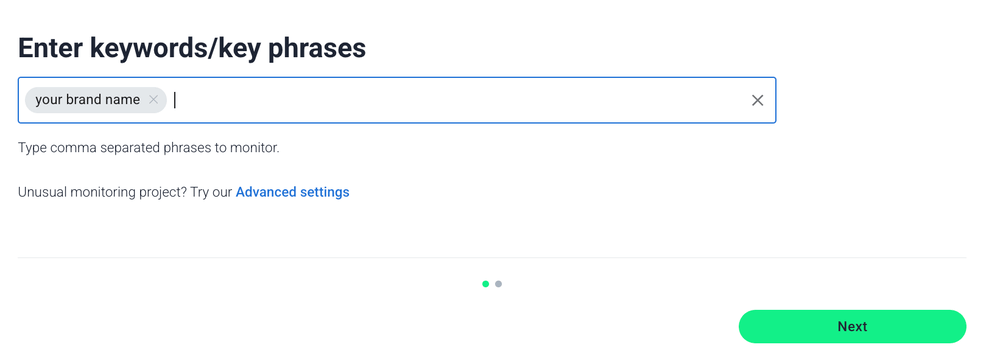
3. Link your Facebook profile for better accuracy.
Most tools let you connect your brand’s Facebook page directly, which helps catch more mentions and gives you cleaner data:
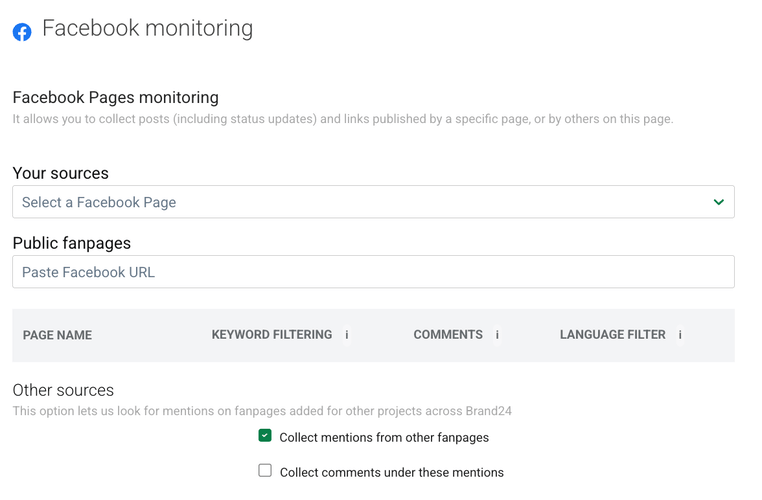
4. Filter noise – exclude non-related topics, sort Facebook data by influence or date.
It’s super important, especially for brands with non-unique names.
Take Apple – I got a whole “Apple recipes” topic page that is absolutely not relevant to the tech giant I need to analyze.
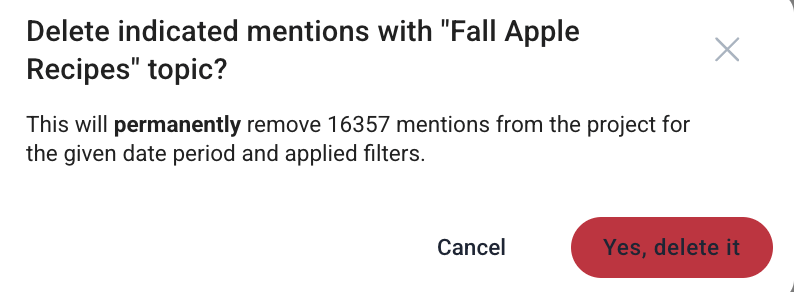
5. Enable alerts, set up reports, and review the initial social media data.
The best part about Facebook listening tools? They ping you instantly when something’s happening, a sudden spike in mentions, a viral comment, or a crisis you need to jump on before it spreads.
Take advantage of this option!
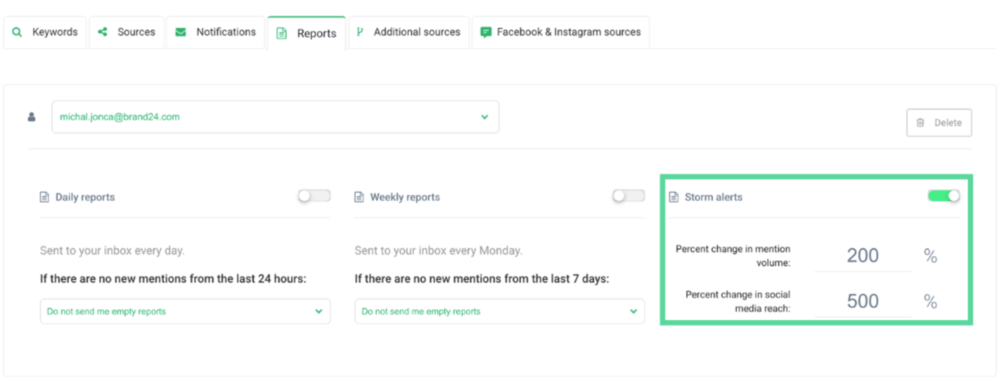
And there you go – you’re now all set!
Of course, these steps are just the basics. The best Facebook monitoring tools offer much more in-depth analysis.
Be sure to explore all the features your tool offers and improve your monitoring efforts.
04 Analisar os dados
And the final, yet probably most important question: How should you analyze the data?
In simple words, look for patterns, not just posts, and turn your findings into actions.
Yes, social listening is a deep field. You could drown in metrics if you wanted to.
But I know you don’t.
Sentiment scores, share of voice, topics, influencers… the list goes on. But let’s cut through the noise.
Here are the metrics that actually move the Facebook listening needle:
01 Sentiment & emotion analysis
Análise de sentimento do Facebook reads between the lines.
It uses natural language processing to figure out how people actually sentir when they post about you:
- positivo
- negativo
- or neutral
Why does that matter? Because you can spot what makes your audience light up and what pisses them off.
You catch concerns before they blow up.
You know which product features to double down on and which ones need fixing.
Track sentiment over time, and you’ll see if your brand reputation is climbing or quietly tanking.

02 Alcance da mídia social
Social media reach shows how many people could see your Facebook mentions and posts.
It adds up all the public conversations where your brand appears.
Why does that matter?
Because reach tells you if your message is suitable for your target audience. It helps you track how your campaigns perform.
Track reach over time, and you’ll see which formats, pages, and topics actually expand your audience.

03 Compartilhamento de voz (SOV)
Share of voice (SOV) compares your mentions to competitors.
It answers a simple question: out of all brand talk in your category, how much is about you?
Why does that matter? Because SOV predicts who sets the narrative.
If your SOV is sinking, someone else is stealing attention. It’s a great food for thought – what are they doing better?

04 Topic analysis
Topic analysis groups what people talk about: features, problems, use cases, memes.
It uses keywords and clustering to surface themes like “battery life,” “shipping,” or “trade-in.”
Why does that matter? Because topics tell you what to create next and where risk hides.
Sometimes your brand gets mistaken for something unrelated (another company, a meme, a product nickname). That noise can snowball and turn into a reputation threat if it carries complaints or misinformation.
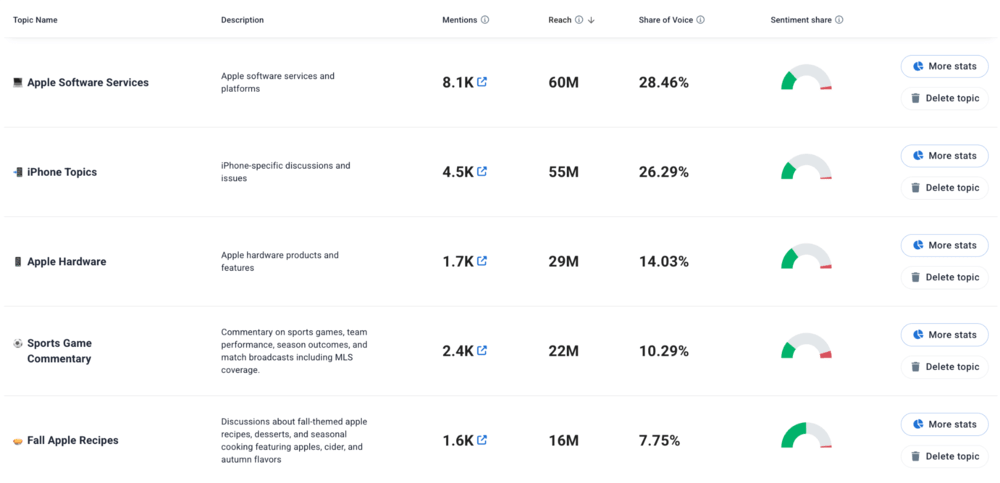
05 Influencer analysis
Influencer analysis finds the authors who move conversations. It looks at who posts about you, how far their content travels, and how people react.
Brands can discover potential influencers and advocates through social listening by identifying individuals who engage positively with their products.
It looks at who posts about you, how far their content travels, and how people react.
Why does that matter? Because a few right voices can shift sentiment and sales.
- Back creators who spark helpful threads and positive engagement.
- Educate or avoid voices that drive confusion or drama.
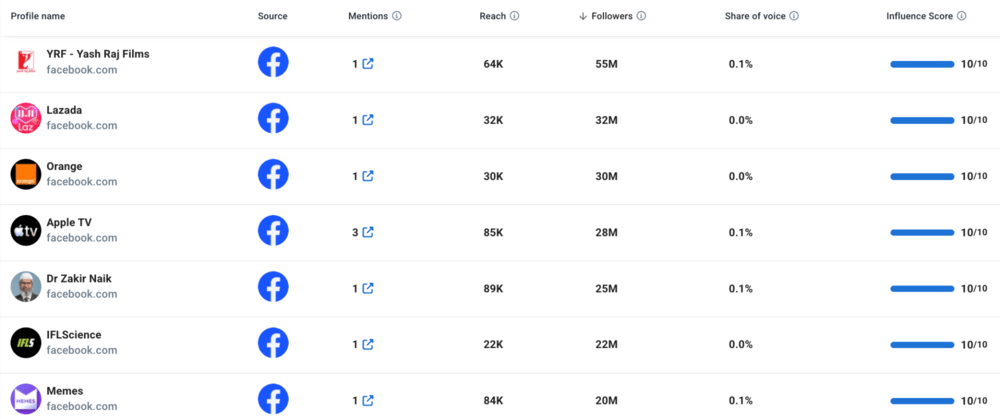
Advanced Facebook social listening techniques and tips (Q&A)
Already comfortable with the basics?
Well, here are the most common Facebook listening questions with a quick answer/tutorial:
How do I cut noise fast?
Use a Boolean search.
Combine AND, OR, NOT, and quotes to keep only relevant conversations.
Example: (“apple iphone” OR #iphone) AND (camera OR battery) NOT (“apple pie”).
You’ll get cleaner data and better insights.
How do I spot a crisis before it becomes a problem?
Turn on an AI Events Detector.
It flags anomalies (like sudden jumps in mentions or sentiment).
Click the alert, find the source post/creator/ad, and act before it escalates.
How do I focus on what actually matters?
Use filters.
Sort mentions by influence to get the high volume ones first, filter “negative” to get just the warning talk.
This turns “a lot of talk” into “one priority we can fix now.”
How do I make sure the right team sees the right mention?
Connect integrations.
Send alerts to Slack/Teams, share reports to all teams.
This way, support can address service issues, while the product identifies crucial needs for updates.
How do I turn raw data into actions quickly?
Use an AI Brand Assistant.
It summarizes threads, surfaces actionable insights, can suggest replies, and proposes creative angles – like ChatGPT, but powered by your social data.
How do I pick suitable influencers for my brand?
Check the Influencer Tab.
It ranks authors by reach, engagement, and the number of times they have already mentioned you.
How do I keep stakeholders aligned without manual reports?
Automate shareable reporting.
Set up automated reports that include brand mentions, social media reach, share of voice, top topics (or generally any other metric you need).
Creating detailed reports based on social listening insights can guide marketing strategy.
Everyone stays in sync, and you save hours.
How do I keep my setup effective month after month?
Refresh and prune monthly.
Update keywords, tweak Boolean excludes, drop dead topics, and add new industry trends.
Your Facebook social listening stays clean, current, and outcome-driven.
How often should businesses conduct social listening on Facebook?
Businesses should do it continuously – daily for customer needs, weekly for campaign performance, and monthly or quarterly for strategic insight.
Successful Facebook social listening campaigns [Case study]
Before the Super Bowl, CeraVe ran a funny teaser idea: actor Michael Cera kept appearing with CeraVe products, sparking jokes that he was the brand’s creator… or even “in the lotion.”
Fans, creators, and pages shared the clips and memes, so the rumor grew globally, also across Facebook.
During the game, CeraVe released a quirky ad where Michael Cera pitched the CeraVe board.

The simple joke + celebrity twist + weeks of build-up made the reveal land big.
Result: huge reach (billions of impressions reported) and a clear 25% sales lift.
This campaign proves that humor, pop culture, and a well-timed reveal can go viral on Facebook.
Conclusão
Facebook social listening helps you turn everyday posts and comments into clear actions.
You see what people say, how they feel, and which topics spread. Then you adjust your content, support, and product based on real feedback.
- The best tools for most teams are Sprout Social, Brand24, and Sprinklr.
- The key Facebook metrics to track are brand mentions, sentiment, share of voice, reach, and topics. These metrics tell you what is working now and what to fix next.
- If a brand ignores social listening in 2025, it misses key insights, lets others shape its story, and reacts too late to issues. Competitors will capture attention and trust.
Don’t miss another opportunity! Start a Brand24 14-day free trial!



